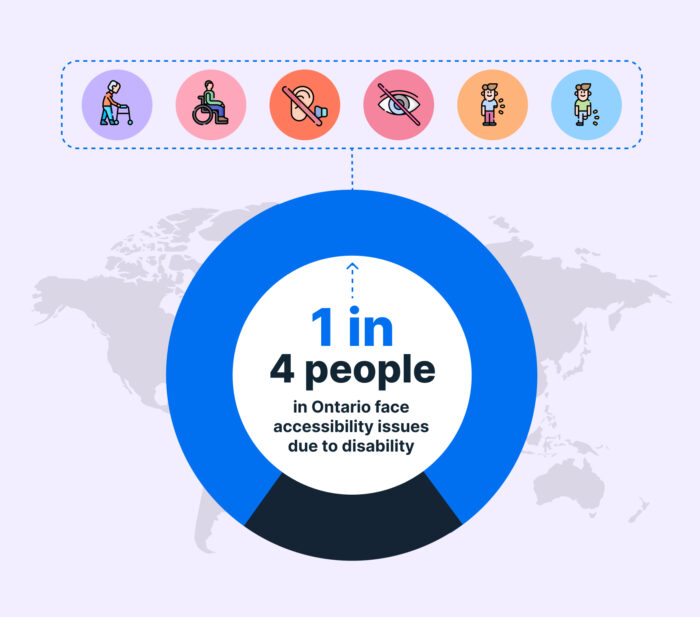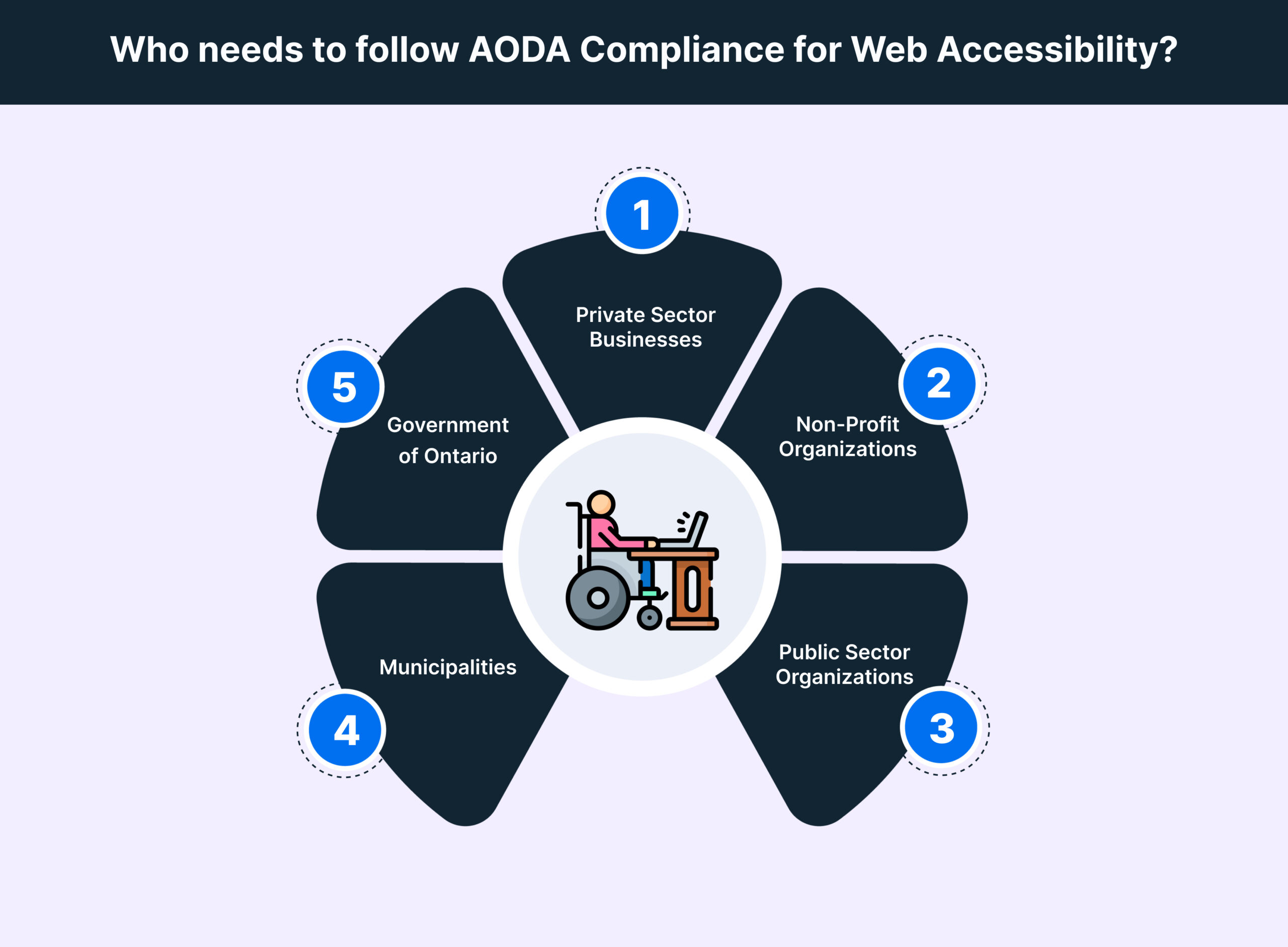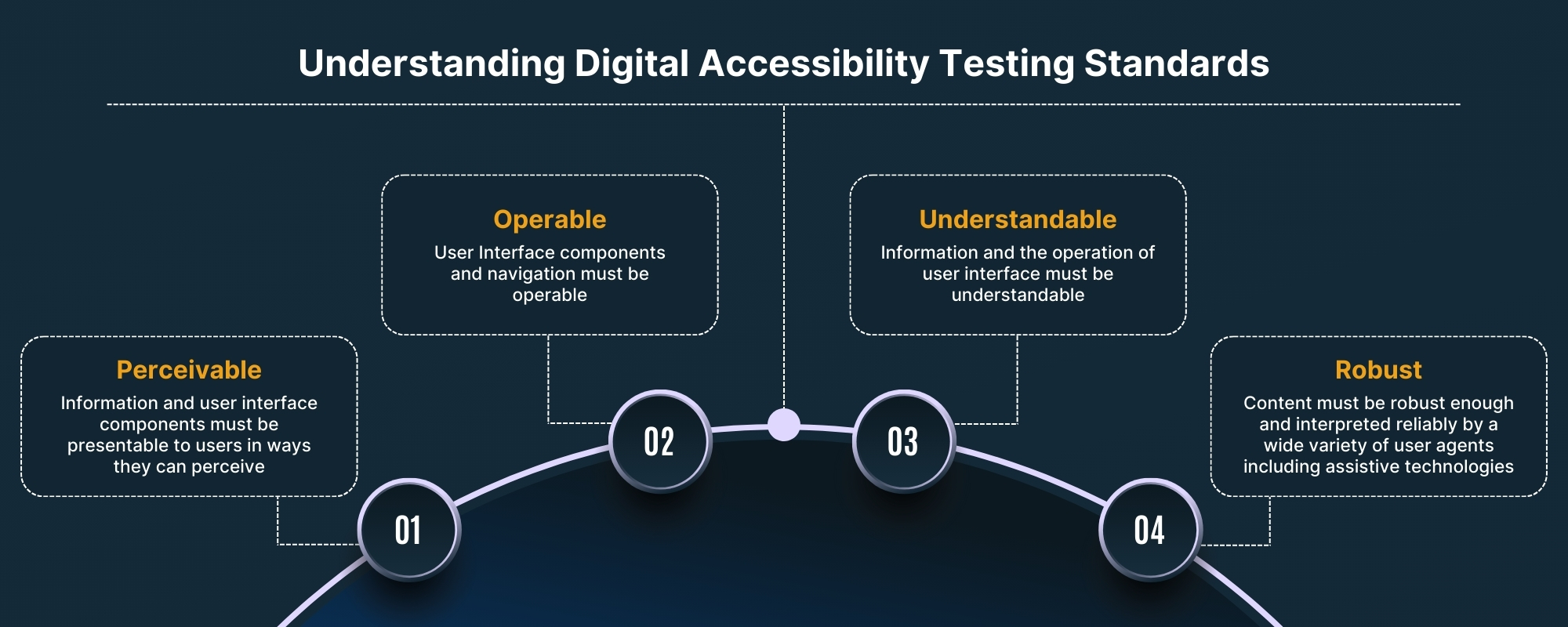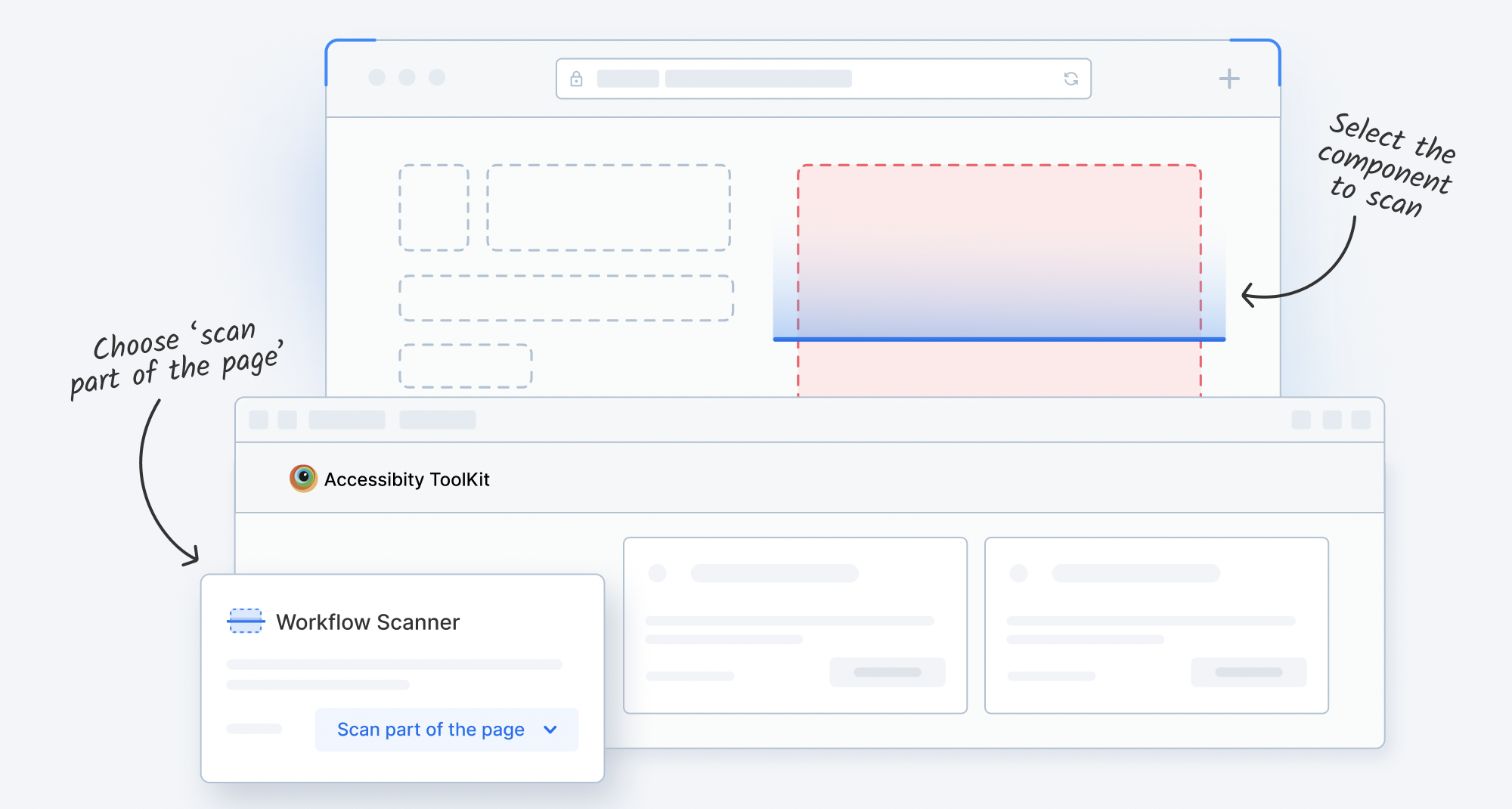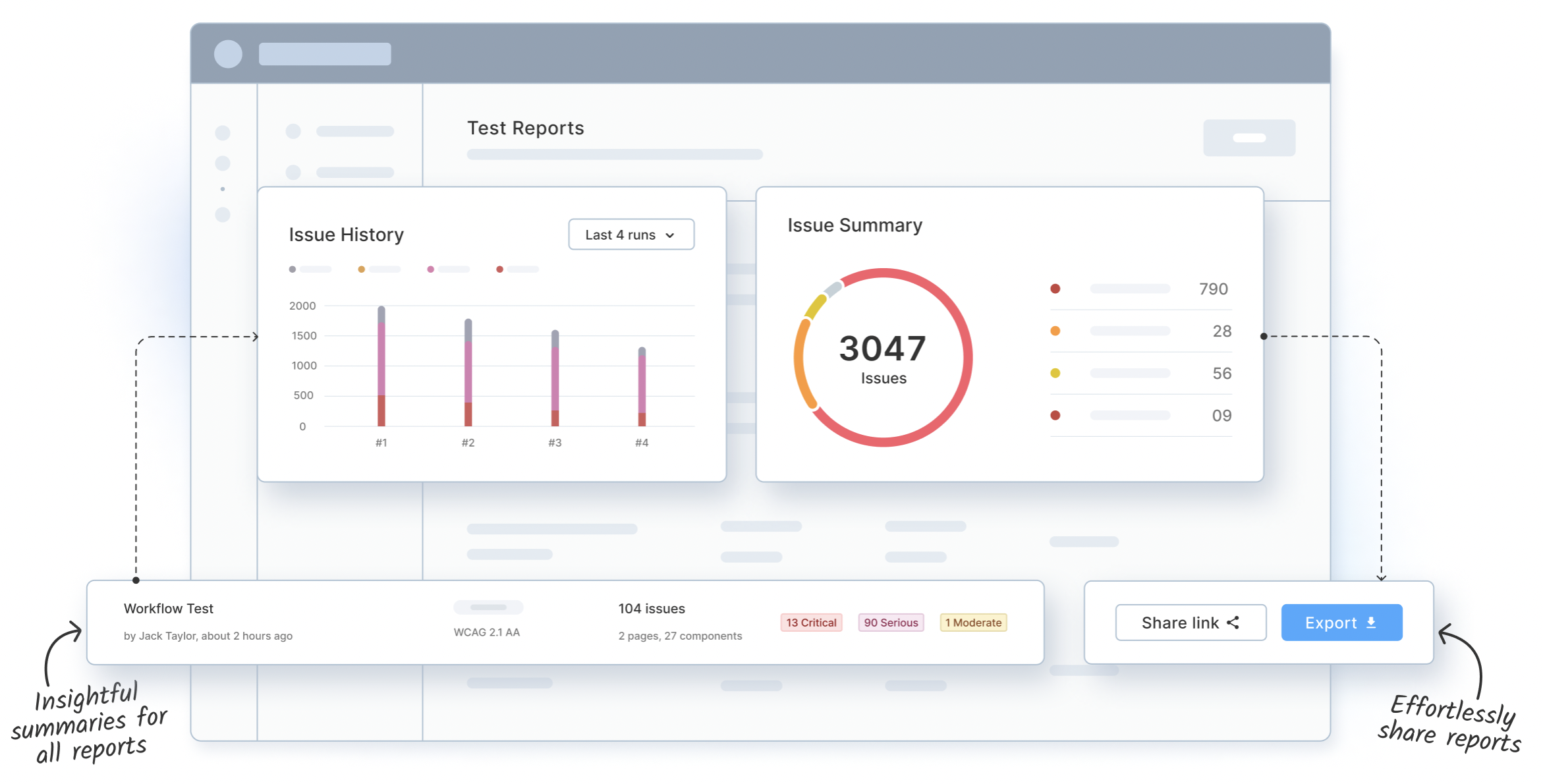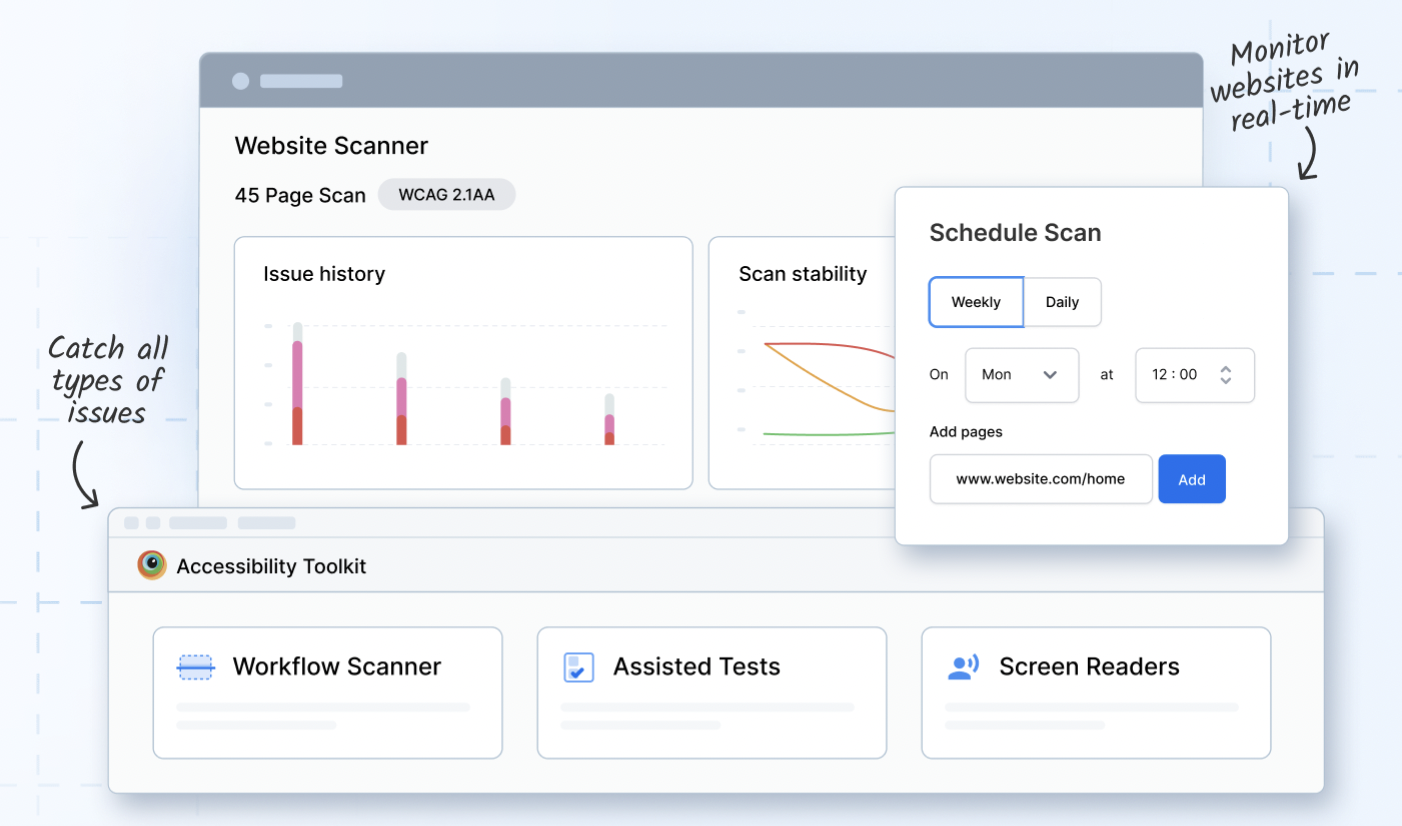What is AODA Compliance?
What is AODA Compliance?
AODA (Accessibility for Ontarians with Disabilities Act) is a provincial law in Ontario, Canada, that aims to make the province accessible for people with disabilities by setting standards for accessibility in various areas of daily life. It ensures that the web content is accessible to all, including people with disabilities.
The AODA was enacted with an aim to achieve accessibility for all Ontarians with disabilities by 2025.
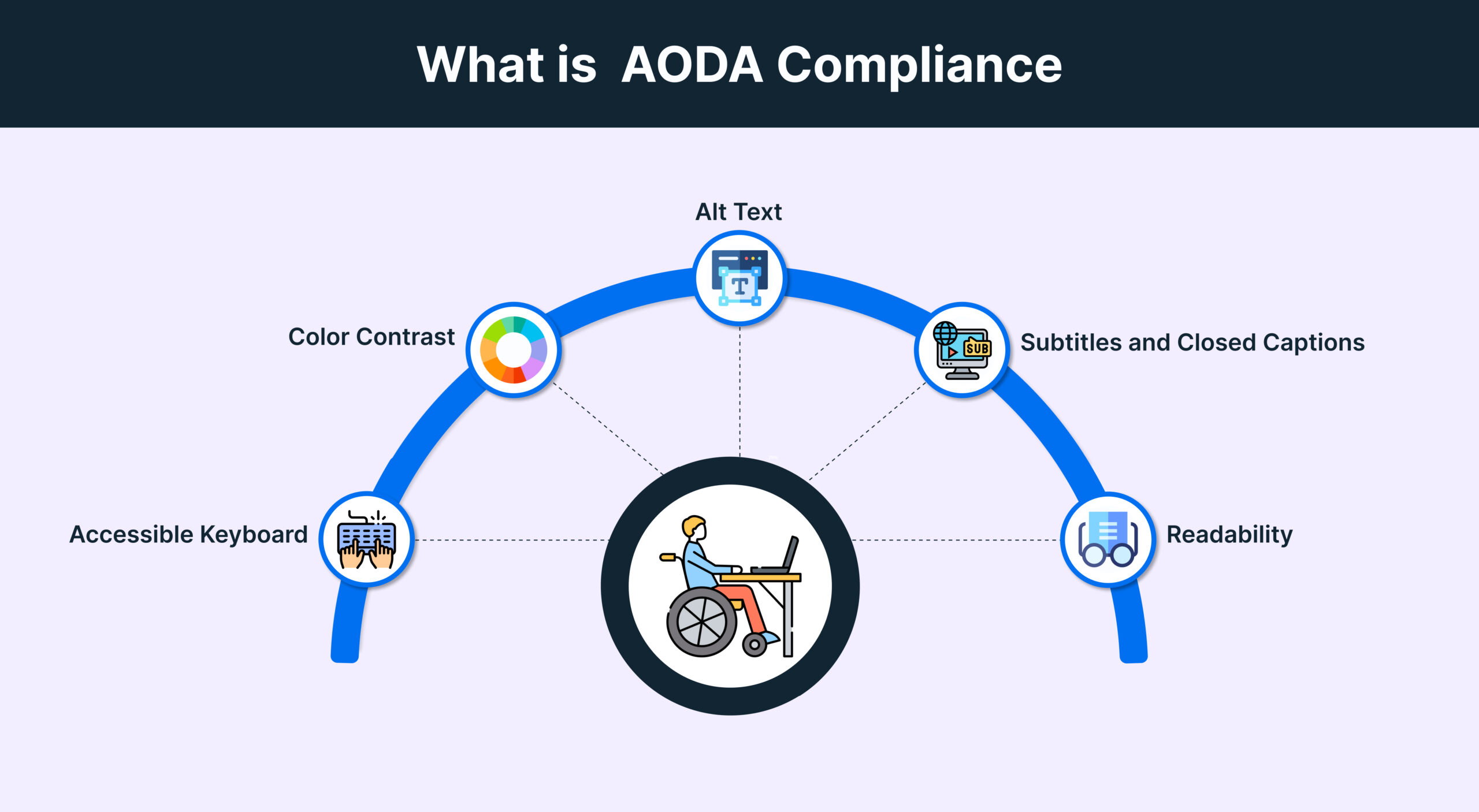
Why is AODA Compliance important?
Did you know that 1 in 4 people in Ontario suffer a disability face various types of accessibility challenges in their everyday life?
This is why AODA compliance is essential. Web Accessibility not only holds moral responsibility, but it also holds business implications.
Web Accessibility helps businesses with,
- Target Larger Audience
- Avoiding Lawsuits and Penalties
- Establishing Brand Recognition
Target Larger Audience
In Ontario, approximately 2.6 million people have a disability. As the aging population is expected to grow in the next 25 years, it is projected that the number of people living with a disability is also expected to grow in Ontario.
Avoiding Lawsuits and Penalties
Failure to comply with the AODA may lead to severe penalties where,
- Individuals and unincorporated entities found in violation of a significant offence under the AODA Act may face fines of up to $50,000 per day for each ongoing violation.
- Corporations found guilty of offences under AODA compliance may be subject to fines of up to $100,000 per day.
- Directors and officers of a corporation, holding fiduciary responsibility, who are found guilty of negligence in AODA compliance may be liable for fines of up to $50,000 per day.
Establishing Brand Recognition
Prioritizing accessibility efforts signals to users that your brand is reliable and values the diverse needs of its user base. There is a growing trend among consumers to prefer businesses emphasizing accessibility and inclusivity.
Adhering to AODA compliance not only enhances your brand’s reputation but also cultivates a positive perception among both customers and the broader public.
Adhering to AODA Compliance is a proactive measure to ensure all-inclusivity and reduce the risk of legal lawsuits and penalties. It also contributes to improved brand recognition and fosters business growth by expanding your reach to a larger and more diverse target audience.
Who needs to follow AODA Compliance for Web Accessibility?
AODA applies to organizations and businesses in the province of Ontario, Canada. AODA compliance requirements are for the following types of entities:
- Private Sector Businesses (Corporations and Partnerships): This includes both large and small businesses operating in Ontario.
- Non-Profit Organizations: Non-profit organizations, regardless of their size, are required to comply with AODA standards.
- Public Sector Organizations: This includes government offices and agencies at different levels. Also, organizations such as hospitals, schools, and universities that receive public funding.
- Municipalities: Municipal governments in Ontario must also adhere to AODA standards.
- Government of Ontario: The provincial government itself is obligated to comply with AODA standards.
What are the AODA-compliant website requirements?
AODA compliance states that as of January 1, 2021, all public websites that meet the required criteria must be made accessible. It outlines that Electronic information and communication must adhere to the Web Content Accessibility Guidelines (WCAG) 2.0.
WCAG Compliance is developed by the World Wide Web Consortium (W3C). It is widely regarded as one of the most influential sets of guidelines influencing global web accessibility policies. WCAG compliance is based on the 4 Key Principles:
- P- Perceivable
- O- Operable
- U- Understandable
- R- Robust
These Core Principles lay the foundation for the below WCAG guidelines that should be followed for AODA compliance.
| 1. | Perceivable | |
|---|---|---|
| 1.1 | Text Alternatives | Provide Text Alternatives to different non-text content forms so that it can be used by assistive technology such as screen readers, braille, large print, symbols, or easy language. |
| 1.2 | Time-based Media | Provide Captions, alternatives or audio descriptions for pre-recorded and live time-based media such as audio or video. |
| 1.3 | Adaptable | Create content that is adaptable to different forms without losing out on the information or its structure. |
| 1.4 | Distinguishable | Make content easier for the user to see and hear so that they can separate the foreground from the background. |
| 2. | Operable | |
| 2.1 | Keyboard Accessible | Make all the functionality of the website accessible from a keyboard without requiring specific timings for individual keystrokes. |
| 2.2 | Enough Time | Give enough time to the users to read and act on the content. |
| 2.3 | Seizures | Content design should not have anything that flashes more than 3 times to avoid causing seizures due to photosensitivity. |
| 2.4 | Navigable | Help users navigate through the workflows and webpages, find content, and determine where they are on the website. |
| 2.5 | Input Modalities (WCAG 2.1 & WCAG 2.2) | Make it easier for the users to operate functionalities using different inputs apart from the keyboard. |
| 3. | Understandable | |
| 3.1 | Readable | Create content that is readable and easy to understand using clear and simple language. |
| 3.2 | Predictable | Design content and pages in a predictable way, where users can easily predict how to operate. |
| 3.3 | Input Assitance | Help users provide correct information and correct mistakes through ways like clear instructions and error prevention techniques. |
| 4. | Robust | |
| 4.1 | Compatible | Create a website with maximum compatibility with the current and future user agents such as browsers, devices, and platforms, including assistive technologies. |
Read More to know about WCAG Compliance and Guidelines in detail
AODA Deadline and Consequences
AODA has two time frames for web-accessible content:
- All websites have to reach WCAG 2.0 Level A compliance by January 1st, 2014
- Websites have to reach WCAG 2.0 Level AA (other than criteria 1.2.4 (live captions) and 1.2.5 New Window (pre-recorded audio descriptions) by January 1st, 2021
If AODA compliance deadlines are not duly followed it may lead to severe penalties where,
- Individuals and unincorporated entities found in violation of a significant offence under the AODA Act may face fines of up to $50,000 per day for each ongoing violation.
- Corporations found guilty of offences under AODA compliance may be subject to fines of up to $100,000 per day.
- Directors and officers of a corporation, holding fiduciary responsibility, who are found guilty of negligence in AODA compliance may be liable for fines of up to $50,000 per day.
How to test AODA Compliance using BrowserStack Accessibility Testing
BrowserStack Accessibility Testing is an integrated platform that detects both fundamental and intricate accessibility issues at speed. It is a one-Stop Solution to
- Test,
- Report, and
- Monitor Web Accessibility Health.
Test Web Accessibility for AODA Compliance
You can test AODA Compliance of your website using BrowserStack Accessibility Testing Tool. It provides core features to:
- Test any user workflow in a single scan using Workflow Scanner
- Identify complex accessibility issues by answering simple, auto-generated questions using Assisted Tests
- Precisely locate issue sources using Screen Readers on Real Devices
You can run Workflow Scanner to Scan user flows across full page scan or test part of a page for accessibility. Use the Workflow scanner to automatically identify and report basic issues such as missing alt text, insufficient color contrast, among others at blazing speed.
Try BrowserStack Accessibility Testing
Workflow Scanner allows you to choose the required WCAG versions and its conformance level, for example, WCAG 2.0 AA. It highlights all the Web Accessibility Issues along with their details. This helps you meet the AODA Compliance requirements of reaching WCAG compliance A or AA for your website.
Report Web Accessibility Issues for AODA Compliance
BrowserStack Accessibility Testing Tool provides you access to all reports from the past and present scans on one single dashboard. You can combine multiple reports into one in seconds and use the insightful issue summaries for better debugging.
You can get details on Issue Summary and Workflow Log Reports within the dashboard. All reports contain issues that are grouped on the basis of violating WCAG guidelines. It enables easier VPAT report creation.
You can also select multiple reports to create a consolidated report that can be shared or exported as a CSV file.
Learn More about Accessibility Testing
Monitor Web Accessibility for AODA Compliance
BrowserStack Accessibility Testing Tool also allows you to schedule scans at regular intervals and get a detailed Accessibility report with Website Scanner. Once the workflow is scanned, you can get details on Issue Summary and Workflow Log Reports within the dashboard.
Schedule Website Scan for WCAG Compliance Now
Best Practices for AODA Compliance
Some of the key best practices to follow for being AODA compliant are:
- Understand and Implement WCAG Standards to meet AODA Requirements.
- Track WCAG 2.0 AA and AAA using a checklist.
- Use HTML Markup in the content as per the accessibility standards.
- Create simple workflows that are easily understandable.
- Make user-friendly Design Navigation.
- Create interactive elements that are easy to identify.
- Create designs considering different viewport sizes.
- Perform cross-browser compatibility tests on the website regularly.
- Use Automation tools to check Accessibility regularly.
- Run usability tests with users across the disability spectrum.
- Create VPAT reports regularly and track Web Accessibility conformance.
AODA Compliance Checklist
Here’s a handy checklist that can help you make an AODA-Compliant website based on WCAG 2.0 compliance:
- Insert alternative text tag on visual assets.
- Ensure that the electronic content is compatible to screen readers.
- Use contrasting colors to make content perceivable.
- Accommodate keyboard navigation.
- Keep text font and size easy to view.
- Create interactive elements that are operable.
- Use Digital Accessible Information Systems (DAISY) audio format.
- Use structured and well-defined headlines and descriptions for a clear content hierarchy
- Add subtitles and captions to videos
- Avoid seizures due to photosensitivity by avoiding any flashing lights or blinking bright elements on the website.
- Use clear labels in forms for a better understanding.
- Use pop-ups and alerts to help users avoid mistakes.
- Make it easy to correct mistakes if they occur using options like Back and Edit.
- Use concise language in text content for easy understanding.
- Build website that is compatible with current and future user agents (including assistive technologies).
Conclusion
AODA compliance ensures Ontario is an accessible and inclusive province for everyone. AODA compliance promotes web accessibility for all. To make AODA compliant website, WCAG 2.0 AA and AAA should be adhered to based on the cut-off timelines. Through its 4 Principles and Guidelines, WCAG offers a detailed framework to test accessibility and ensure that the website has an all-inclusive design.
By running Accessibility Tests based on the WCAG you can keep a check on the AODA compliance of the website and follow all the guidelines to deliver web content that is easily accessible to all.
